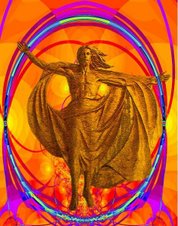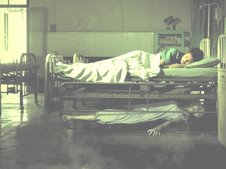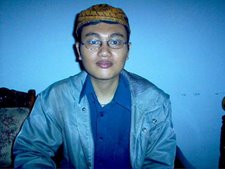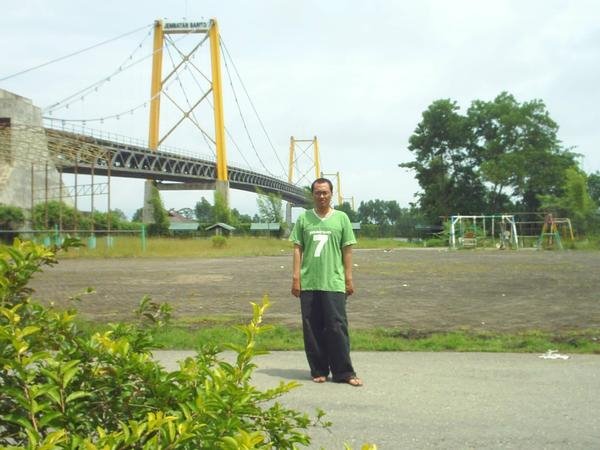Friday, April 27, 2012
Bara (genre)
From Wikipedia, the free encyclopedia
Jump to: navigation, search
"Gay manga" redirects here. For the genre by and for women, see Yaoi.
Bara (???, "rose"), also known as the wasei-eigo construction "Mens' Love" (?????, menzu rabu?) or ML, is a Japanese jargon term for a genre of art and fictional media that focuses on male same-sex love and desire, usually created by and for gay men. The bara genre began in the 1960s with fetish magazines featuring gay art and content. Besides bara manga, also called gei comi (?? ???, "gay comics"), and illustration, a number of bara erotic games exist, as well as novels and memoirs. Bara is mostly a Japanese phenomenon, with limited western exposure through manga scanlations and online homoerotic art communities. While bara faces difficulties finding western publishers, it has been described as "the next big porn wave coming out of Japan."[1]
Bara can vary in visual style and plot, but typically features masculine men with varying degrees of muscle, body fat, and body hair, akin to beefcakes, or bears (??, kuma) in gay culture. While bara usually features adult content (sometimes violent or exploitative) and gay romanticism, it often has more realistic or autobiographical themes, as it acknowledges the taboo nature of homosexuality in Japan.
Western commentators sometimes refer to bara as "yaoi", but yaoi is largely created by and for women and features idealized bishonen who frequently conform to the heteronormative formula of the dominant and masculine seme and effeminate uke characters.[2] By contrast, bara is considered a subgenre of seijin (men's erotica) for gay males and resembles comics for men (seinen) rather than comics for female readers (shojo/josei).
Contents
[hide]
* 1 Terminology
* 2 History
* 3 Manga
o 3.1 Popular creators
o 3.2 Publishers
o 3.3 Online stores and the foreign market
o 3.4 Characteristics of bara manga
* 4 Other media
o 4.1 Novels and memoirs
o 4.2 Games
* 5 Bara versus yaoi
o 5.1 Gachi muchi
* 6 See also
* 7 References
[edit] Terminology
The term bara in relation to gay material for men originated in the 1960s, possibly as a result of Bara kei (Ordeal by Roses, published in 1961), a collection of semi-nude photographs of the gay author Yukio Mishima by photographer Eikoh Hosoe,[3] and was reinforced by the early and influential gay men's magazine Barazoku (????, lit. "rose tribe"), founded in 1971 and the first gay magazine in Asia to be sold at mainstream bookshops.[4] Bara-eiga ("rose film") has been used since the 1980s to describe gay cinema.[5] [6]
[edit] History
Japan has a history of homosexuality, particularly pederasty, which is represented in danshoku-shunga artwork. However, Gengoroh Tagame distinguishes between the culturally-defined sexuality of traditions (such as pederasty) and the more personal, innate, and arguably legitimate sexuality found in modern homoeroticism.[7]
According to Tagame, the history of modern gay erotic art in Japan can be traced to Fuzokukitan, a fetish magazine which ran between 1960 and 1974. While it contained heterosexuality and lesbianism, Fuzokukitan stood apart from its competitors as it gradually featured more gay content and articles, and had male erotic art as its cover several times more frequently than other publications. Western artists George Quaintance and Tom of Finland, who contributed to American physique magazines, were featured in Fuzokukitan, and several historical bara artists, including Okawa Tatsuji, Funayama Sanshi, Mishima Go and Hirano Go made their debut in the magazine, in addition to featured work by popular artists such as Oda Toshimi and Adachi Eikichi. A prominent figure behind the publication was writer and editor Mamiya Hiroshi, who later contributed to Barazoku. The publication continued to grow, but by the end of the 1960s all the previously mentioned artists had left Fuzokukitan.[7]
A privately published, small circulation magazine called Bara was established in 1964 and became "the root of gay magazines." Mishima, Funayama and Adachi contributed to Bara after leaving Fuzokukitan, likely the reason for the latter publication's demise. In 1971, Barazoku, the first commercially published gay men's magazine, was established. Several other new magazines, Sabu and Adon, soon followed, introducing newer artists such as Ishihara Gojin and Hayashi Gekko.[7]
Homoerotic photography has also been accredited as contributing to the bara genre, with Tamotsu Yato and Haga Kuro mentioned by Tagame in particular. In the 1970s and 1980s, gay magazines grew rapidly and began specializing in particular fetishes such as "chubby chasers", allowing artists to specialize. Foreign gay cultures, art, and lifestyle found their way into publications such as MLMW, increasingly influencing the next second generation of bara artists, including Sadao Hasegawa, published in Barazoku, Sabu, Adon, MLMW, Samson, and later SM-Z, as well as artists Junichi Yamakawa and Kimura Ben, whose depiction of men were more sporty and realistic. With the second generation of artists, the generalized sorrow and darkness noticeable in the work of the first generation soon disappeared, as gay people in Japan became more liberated. Gay sexualized fantasies shifted from the spiritual beauty of samurai and gangsters to the physical bodies of sportsmen.[7]
After the second generation, in the late 1980s and 1990, the major gay magazines continued publishing but extra issues, picture books, and large-sized magazines disappeared as general interest magazines started to often feature gay interest articles.[7] Mid-1990s magazines such as Badi and G-men were more inclusive of gay culture and dealt with topics such as the gay market, pride parades, HIV-related events, and clubs, although the focus remained on fiction, ads and erotic material. In the early 1990s Adon attempted to shift its focus onto lifestyle and politics and away from the eroticism and light entertainment typical of the gay magazines of the era, eliminating pornographic features[8] and reducing its photographic and fiction sections. This shift was not successful and the magazine went out of business in 1996.[9] Barazoku ceased publication in 2004,[4] made several failed attempts to restart,[10] and is now defunct. The demise of Barazoku has been linked to a preference for coverage of "sex, music, clubbing and fashion, rather than news and politics" among modern readers.[4] Sabu also eventually failed, ceasing publication in 2001.[7]
Today, there are more gay artists and variety featured in gay magazines compared to the 1990s.[7]
[edit] Manga
Bara manga, also known as gei comi, is an even smaller niche genre in Japan than yaoi manga;[11] no completely bara work has been licensed in English,[12] although two chapters of the mostly-mainstream translated yaoi manga Red Blinds the Foolish were originally published in the bara magazine Gekidan, and a few of Gengoroh Tagame's works have been published in French.[13] Not much has been scanlated into English,[11] although Kuso Miso Technique, a 1987 one-shot manga published in Barazoku, has become an Internet meme.[14]
[edit] Popular creators
Gengoroh Tagame has been called the most influential creator of gay manga in Japan to date. Most of his work first appeared in gay magazines and usually features sexual abuse, including rape, torture, and BDSM. Tagame's illustrations of muscular, hairy men have been cited as a catalyst for a shift in fashion among gay men in Tokyo after the launch of G-men in 1995, away from the clean-shaven and slender styles influenced by yaoi and towards a tendency for masculinity and chubbiness.[15] Tagame's work has been criticized by notable gay manga writer Susumu Hirosegawa as being merely "SM theatre", because of its violence and lack of complex storylines.[15] Susumu Hirosegawa's early works were yaoi, but later Hirosegawa moved into gay manga. Hirosegawa's works sometimes contain no sex at all, with greater focus on plot, but when sex is present it is often in the form of sadomasochism or rape, in which the victim learns to enjoy the experience.[15]
Other popular and well-known artists include Takeshi Matsu, Inaki Matsumoto, Mentaiko and Matsuzaki Tsukasa.[16]
[edit] Publishers
[icon] This section requires expansion.
Prior to the early 2000s, the primary venue for publication of gay men's manga was gay men's general-interest magazines, which have included manga since the inception of Barazoku in 1971. The typical manga story in these magazines is an 8-24 page one-shot, although some magazines, notably G-men, also carry some serialized stories. McLelland, surveying gay men's magazines from the mid to late 1990s, indicates that most manga stories were simply pornographic, with little attention to character or plot, and that even the longer, serialized stories were generally "thinly developed".[17] McLelland characterizes Barazoku as containing "some well-crafted stories which might be better described as erotic rather than pornographic", while the manga in G-men were "more relentlessly sexual", with less attention to characterization and mood.[18]
Much of Gengoroh Tagame's early work was published in the magazine G-men, which was founded in 1994 to cater to gay men who preferred "macho fantasy", as opposed to the sleeker, yaoi-inspired styles popular in the 1980s.[19] Like most gay men's general-interest magazines, G-men included manga as well as prose stories and editorial and photographic material. G-men encouraged steady readership by presenting a more well-defined fantasy image, and with serialized, continuing manga stories which encouraged purchase of every issue.[20] Gengoroh Tagame's work was an important influence on G-men's style; he provided the cover for the first 60+ issues, as well as manga stories for most issues. G-men was also one of the first gay men's publishers to offer collections of manga bound into tankobon.[citation needed]
The 1990s saw increased media focus on LGBT people in Japan, and a large increase in the production of works written by gay men. In the mid to late 1990s, several attempts were made at manga anthologies targeted at gay men, but none was successful and most folded after a few issues.[12][21] In the early 2000s, G-men's parent company, Furukawa Shobu, began publishing a pair of manga anthology aimed at gay men, Bakudan (quarterly) and Gekidan (bimonthly); material from these anthologies are collected into tankobon under their Bakudan Comics imprint.[21] These magazines were successful, and Furukawa Shobu added other anthologies, including Uragekidan (defunct) and the BDSM-themed SM Comics Anthology. Shortly thereafter, the yaoi publisher Aqua (an imprint of Ookura Shuppan) started the manga anthology Nikutai Ha (AKA Muscle Aqua), and later others, such as Oaks and G's Comics, to capitalize on a crossover audience of gay male readers as well as female readers who prefer a more masculine body type. These vary between bara and gachi muchi (see below), and have strong gay male components to their readerships; however, when collected into tankobon these manga are issued under the same Aqua Comics imprint as Aqua's mainstream yaoi books, and bear the same trade dress,[22] making them hard to distinguish on the shelf.
As of 2008 there were four major publishers of bara manga anthologies in Japan.[23]
[edit] Online stores and the foreign market
[icon] This section requires expansion.
Some publishers and online stores have extensive English pages and actively seek foreign readers.[23] One of the first online stores to carry bara and create pages in English to pursue foreign online shoppers was Rainbow Shoppers, who carry both current and dated gay manga, including doujinshi. JPQueen sells almost exclusively to foreign buyers, but do not distinguish between yaoi and bara, making for risky purchases for customers. The G-Project Store, tied to Bakudan's G-Style magazine, does not sell doujinshi but has English pages for foreign buyers. GayJP sells only published releases and no doujinshi, and cater almost exclusively to Japanese buyers.[16]
Spanish comic publisher La Cúpula started releasing bara in Spain, translated to Spanish, in 2008, starting with Jiraiya's works[24] and continuing, in June 2010, with a manga by Gengoroh Tagame.[25]
[edit] Characteristics of bara manga
The rise of bara anthologies has promoted longer, serialized stories, but the most common story type is still the single-chapter one-shot. Bara manga usually has muscular men as the lead gay characters, but characters may vary in body type (although they do not approach the feminine litheness common in yaoi). Although some stories contain less idealized and more realistic depictions of the actual life of gay men (gay pride parades, gay marriage issues, "coming out", realistically played out sex etc.), McLelland and others note that frequently "there is more emphasis upon sex than there is on building an enduring relationship".[17] Stories in gay men's general interest magazines from the mid to late 1990s generally present age-, status- or power-structured relationships, where the older or more senior character uses younger or subordinate characters for sexual purposes.[26] Both McLelland[26] and Lunsing[15] indicate that themes of BDSM and violent or exploitative sex are common in this material and intended to be erotic. Lunsing notes that some of the narrative annoyances that gay men express about yaoi manga, such as rape, misogyny, and an absence of a Western-style gay identity, are also present in gei comi.[15] In more recent manga published in gay-targeted anthologies, stories frequently invert the older-top, younger-bottom dynamic and show younger, shorter, often white-collar "tops" in aggressive pursuit of older, larger, often bearded, typically blue-collar "bottoms".[27] As with yaoi, the "bottom" is often presented as shy, reluctant, or unsure of his sexuality. Non-consensual sex and BDSM are still common themes,[28] although romantic themes are also popular.[21]
[edit] Other media
[edit] Novels and memoirs
[icon] This section requires expansion.
See also: LGBT literature
Since the 1990s "gay boom", which brought increasing attention and commercial viability to gay-themed media, there have been a number of novels by gay male authors dealing with homosexuality in a realistic, often autobiographical manner.[6] Notable authors include Hiruma Hisao, Nishino Koji and Ryosuke Hashiguchi;[6] a number of Hashiguchi's works have been made into films, including A Touch of Fever and Hush!.
[edit] Games
Question book-new.svg
This section does not cite any references or sources. Please help improve this section by adding citations to reliable sources. Unsourced material may be challenged and removed. (September 2009)
A number of bara ero-games aimed at a gay male audience have been produced in Japan, although the majority are dojin soft (noncommercial). Unlike commercial yaoi games, which are typically produced by subsidiaries of bishojo game developers (e.g., Nitro+chiral is a subsidiary of Nitro+), the few commercial bara games have been produced by small independent companies. Bara ero-games are typically visual novels, dating sims, or "strip" versions of games of skill such as pachinko or checkers.
[edit] Bara versus yaoi
For more details on this topic, see Yaoi.
Yaoi (????, also known as "Boys' Love" or BL) is another Japanese genre incorporating "gay male romance" themes across various media. The genre emerged in the 1970s in a branch of manga aimed at girls,[6] and is still marketed exclusively at women and girls despite some male readership. BL creators and fans are careful to distinguish the genre from bara, which is created by and for gay men.[29][30] Yaoi has spread beyond Japan: both translated and original yaoi are now available in many countries and languages. The characters in yaoi manga do not tend to self-identify as gay or bisexual.[31][32][33]
Yaoi has been criticized for stereotypical and homophobic portrayals of its characters,[15][34][35][36] and for failing to address gay issues.[30][34] Homophobia, when it is presented as an issue at all,[37] is often used as a plot device to "heighten the drama",[38] or to show the purity of the leads’ love.[34] Matt Thorn has suggested that as yaoi is a romance narrative, strong political themes may be a "turn off" to the readers.[39] Critics state that the genre challenges heteronormativity via the "odd" bishonen ("beautiful boys"),[40][41] and Andrew Grossman has written that the Japanese are more comfortable with writing about LGBT themes in a manga setting, in which gender is often blurred, even in "straight" manga.[42]
Bara is more true to actual gay male relationships, and not the heterosexual-esque relationships between the masculine seme and feminine uke types that are the most common romantic fantasy in women's yaoi manga. In comparison to yaoi, gay men's manga is unlikely to contain scenes of "uncontrollable weeping or long introspective pauses", and more likely to show characters who are "hairy, very muscular, or have a few excess pounds".[43] Compared to gay men's manga, yaoi is "more careful to build up a strong sense of character" before sex scenes occur.[17]
[edit] Gachi muchi
Recently a subgenre of BL has been introduced in Japan, so-called "muscley-chubby BL" or gachi muchi (from gacchiri, muscular, and muchimuchi, chubby) [22] which offers more masculine body types and is more likely to have gay male authors and artists. Although still marketed primarily to women,[22] it is also thought to attract a large crossover gay male audience.[21] Although this type of material has also been referred to as "bara" among English-speaking fans,[23][44] it is not equivalent to gei comi proper (although there is considerable overlap, as writers, artists and art styles cross over between the two genres). Prior to the development of gachi muchi, the greatest overlap between yaoi and bara authors has been in BDSM-themed publications[28] such as Zettai Reido, a yaoi anthology magazine which had a number of openly male contributors.[15] Several female yaoi authors who have done BDSM-themed yaoi have been recruited to contribute stories to BDSM-themed bara anthologies or special issues.[28]
Subscribe to:
Post Comments (Atom)







No comments:
Post a Comment